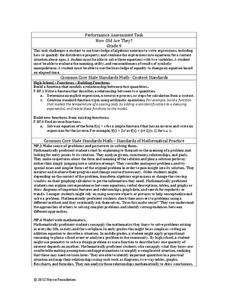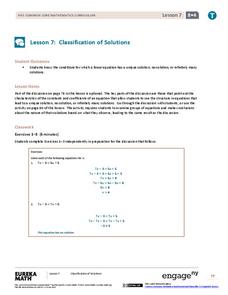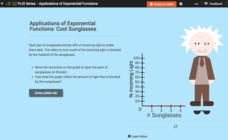Curated OER
Deciphering Word Problems in Order to Write Equations
Help young mathematicians crack the code of word problems with this three-lesson series on problem solving. Walking students step-by-step through the process of identifying key information, creating algebraic equations, and finally...
Virginia Department of Education
Solving Equations
Demonstrate the abstract process of solving equations by using algebra tiles as a concrete representation. Scholars begin by solving equations through the use of manipulatives. As they gain more confidence, they progress to...
Inside Mathematics
How Old Are They?
Here is a (great) lesson on using parentheses! The task requires the expression of ages using algebraic expressions, including the distributive property. Pupils use their expressions to determine the individual ages.
EngageNY
Linear Equations in x
What does it mean to solve an equation? The resource revisits the concept of making a linear equation true. Classmates use algebraic methods to transform sides of equations to expressions with fewer terms. They use substitution to...
Curated OER
Cumulative ACT Practice: Pre-Algebra I and Pre-Algebra II
Here is an ACT practice worksheet where pupils solve pre-algebra problems in an ACT format. This packet contains a pre-algebra section with 15 problems, a pre-algebra II section with 10 problems, and one subtest with 14 problems.
Curated OER
Solving Rational Equations 1
In this Algebra I worksheet, learners solve rational equations that may have extraneous solutions. The worksheet is two pages and contains twenty problems. Answer key is provided.
Illustrative Mathematics
Logistic Growth Model, Abstract Version
Here learners get to flex some serious algebraic muscles through an investigation of logistic growth. The properties of the constant terms in the logistic growth formula are unraveled in a short but content-dense...
CK-12 Foundation
Addition of Polynomials: Splitting into Tiles
Count on tiles to add polynomials. Pupils drag virtual algebra tiles onto colored mats to represent the sum of two polynomials. The learners count the number of like tiles to find the coefficient of each term. They finish...
EngageNY
Classification of Solutions
Is there one, none, or more? Through discussion or activity, scholars find the properties of an equation that will determine the number of solutions. They then use the properties discovered to figure out the number of solutions...
Mathematics Vision Project
Module 1: Sequences
Take steps into sequences. An 11-lesson unit builds upon pupils' previous understanding of writing expressions to develop the idea of sequences. The resource explores both arithmetic and geometric sequences using recursive and explicit...
CK-12 Foundation
Factorization of Quadratic Expressions: Boxes for Factoring
Create rectangles from the terms of a trinomial. The interactive provides virtual algebra tiles for participants to use to create quadratic trinomials. Pupils use the tiles and arrange them into a rectangle to find the factors of the...
Virginia Department of Education
Balanced
Bring balance to your lesson plans with an activity that asks individuals to solve one-step linear equations with inverse operations. Balance scales help learners understand the concept of isolating the variable.
CK-12 Foundation
Exponential Decay: Cool Sunglasses
Who wouldn't want to wear four pairs of sunglasses? Each pair of sunglasses reduces the percent of incoming light by one-half. An interactive tutorial helps young mathematicians build a graph that models this scenario. They...
Curated OER
Math Sheet #5 Systems Of Equations
Solve systems of equations using the substitution or elimination method. Kids can practice by solving each of the five problems on this one-page activity.
Flipped Math
Calculus AB/BC Mid-Unit 1 Review: Limits
Limit the amount one forgets about limits. A mid-unit review lesson has individuals complete a activity of problems on limits. They go over the meaning of limits, evaluate limits algebraically, use graphs and tables to find limits, and...
Curated OER
Using Algebra
Sixth graders explore mathematics by completing equations in a math notebook. They will collaborate in small groups to complete different algebra problems and write their work down in a notebook, which they show their teacher. Then they...
CPM
Unit 3, Worksheet 1, Exponents and Algebraic Expressions
Need exponentt practice? Then this exponent worksheet will be helpful to have learners evaluate exponent expressions and algebraic expressions. They use the distributive property to solve equations. This three-page worksheet contains...
Curated OER
Using Proof in Algebra
In this using proofs in algebra instructional activity, students solve ten different problems related to solving proofs. First, they name the property of equality that justifies each statement given. Then, students complete each proof by...
Curated OER
One Variable Word Problems
Here is a one-variable word problems worksheet in which learners complete word problems dealing with all four operations and one variable. They complete a total of 18 problems.
Curated OER
Worksheet #4: Simplify Algebraic Expressions With Two Variables
In this algebraic expression worksheet, students simplify algebraic expressions and solve proportions, and write equations from story problems. Thirteen of the 49 problems are fill in the blank, and the remainder are multiple choice.
Mathed Up!
Algebraic Fractions
Learn ways to simplify algebraic fractions with a video that reviews how to simplify rational expressions by canceling common factors and how to add and subtract simple rational expressions. A worksheet tests pupils' understanding...
EngageNY
End-of-Module Assessment Task - Algebra 2 (Module 1)
A series of assessment tasks require learners to process information and communicate solutions. Topics include graphing parabolas, solving linear-quadratic systems, factoring polynomials, and solving polynomial equations.
Curated OER
Applying Algebra to the Life of Middle Schoolers
Middle schoolers will read word problems, create questions, and come up with solutions. They are taught to use previous knowledge combined with current content to solve problems logically and algebraically.
EngageNY
The Power of Algebra—Finding Pythagorean Triples
The Pythagorean Theorem makes an appearance yet again in this lesson on polynomial identities. Learners prove a method for finding Pythagorean triples by applying the difference of squares identity.























